The Microscopic Mechanisms of Nonlinear Rectification on Si-MOSFETs Terahertz Detector
Abstract
:1. Introduction
2. Concept of Nonlinear Rectification in a Quasi-One-Dimensional Analysis Model
3. Simulation Model and Equations
4. Simulation Procedure for Finite Element Analysis
5. Impact of Hot Electrons on Optical Detection
6. Conclusions
Author Contributions
Funding
Institutional Review Board Statement
Informed Consent Statement
Data Availability Statement
Conflicts of Interest
References
- Siegel, P.H. Terahertz technology. IEEE Trans. Microw. Theory Tech. 2002, 50, 910–928. [Google Scholar] [CrossRef]
- Akkaş, M.A. Terahertz wireless data communication. Wirel. Netw. 2019, 25, 145–155. [Google Scholar] [CrossRef]
- Ueno, Y.; Rungsawang, R.; Tomita, I.; Ajito, K. Terahertz images of biological molecules: Frequency dependence of spatial resolution using a tunable terahertz laser source. Jpn. J. Appl. Phys. 2008, 47, 1315. [Google Scholar] [CrossRef]
- Dyakonov, M.; Shur, M. Shallow water analogy for a ballistic field effect transistor: New mechanism of plasma wave generation by dc current. Phys. Rev. Lett. 1993, 71, 2465. [Google Scholar] [CrossRef] [PubMed]
- Dyakonov, M.; Shur, M. Two dimensional electronic flute. Appl. Phys. Lett. 1995, 67, 1137–1139. [Google Scholar] [CrossRef]
- Dyakonov, M.; Shur, M. Detection, mixing, and frequency multiplication of terahertz radiation by two-dimensional electronic fluid. IEEE Trans. Electron Devices 1996, 43, 380–387. [Google Scholar] [CrossRef]
- Dyakonov, M.I.; Shur, M.S. Plasma wave electronics: Novel terahertz devices using two dimensional electron fluid. IEEE Trans. Electron Devices 1996, 43, 1640–1645. [Google Scholar] [CrossRef]
- Knap, W.; Dyakonov, M.; Coquillat, D.; Teppe, F.; Dyakonova, N.; Łusakowski, J.; Karpierz, K.; Sakowicz, M.; Valusis, G.; Seliuta, D. Field effect transistors for terahertz detection: Physics and first imaging applications. J. Infrared Millim. Terahertz Waves 2009, 30, 1319–1337. [Google Scholar] [CrossRef] [Green Version]
- Fang, T.; Liu, Z.-Y.; Liu, L.-Y.; Li, Y.-Y.; Liu, J.-Q.; Liu, J.; Wu, N.-J. Detection of 3.0 THz wave with a detector in 65 nm standard CMOS process. In Proceedings of the 2017 IEEE Asian Solid-State Circuits Conference (A-SSCC), Seoul, Republic of Korea, 6–8 November 2017; pp. 189–192. [Google Scholar]
- Jungemann, C.; Linn, T.; Bittner, K.; Brachtendorf, H.-G. Numerical investigation of plasma effects in silicon MOSFETs for THz-wave detection. Solid-State Electron. 2017, 128, 129–134. [Google Scholar] [CrossRef]
- Khan, M.I.W.; Kim, S.; Park, D.-W.; Kim, H.-J.; Han, S.-K.; Lee, S.-G. Nonlinear analysis of nonresonant THz response of MOSFET and implementation of a high-responsivity cross-coupled THz detector. IEEE Trans. Terahertz Sci. Technol. 2017, 8, 108–120. [Google Scholar] [CrossRef]
- Liu, Z.; Liu, L.; Zhang, Z.; Liu, J.; Wu, N. Terahertz detector for imaging in 180-nm standard CMOS process. Sci. China Inf. Sci. 2017, 60, 082401. [Google Scholar] [CrossRef]
- Daher, C.; Torres, J.; Iñiguez-De-La-Torre, I.; Nouvel, P.; Varani, L.; Sangaré, P.; Ducournau, G.; Gaquière, C.; Mateos, J.; González, T. Room temperature direct and heterodyne detection of 0.28–0.69-THz waves based on GaN 2-DEG unipolar nanochannels. IEEE Trans. Electron Devices 2015, 63, 353–359. [Google Scholar] [CrossRef] [Green Version]
- Tanigawa, T.; Onishi, T.; Takigawa, S.; Otsuji, T. Enhanced responsivity in a novel AlGaN/GaN plasmon-resonant terahertz detector using gate-dipole antenna with parasitic elements. In Proceedings of the 68th Device Research Conference, Notre Dame, IN, USA, 21–23 June 2010; pp. 167–168. [Google Scholar]
- Antonov, A.; Gavrilenko, V.; Maremyanin, K.; Morozov, S.; Teppe, F.; Knap, W. Resonance detection of terahertz radiation in submicrometer field-effect GaAs/AlGaAs transistors with two-dimensional electron gas. Semiconductors 2009, 43, 528–531. [Google Scholar] [CrossRef]
- Javadi, E.; Shahabadi, M.; Masoumi, N.; Notario, J.A.D.; Meziani, Y.M.; Perez, J.E.V. Terahertz detection and imaging using an uncooled off-the-shelf GaN high electron mobility field-effect transistor. In Proceedings of the 2017 Iranian Conference on Electrical Engineering (ICEE), Tehran, Iran, 2–4 May 2017; pp. 409–411. [Google Scholar]
- Sangaré, P.; Ducournau, G.; Grimbert, B.; Brandli, V.; Faucher, M.; Gaquière, C.; Íñiguez-de-la-Torre, A.; Íñiguez-de-la-Torre, I.; Millithaler, J.F.; Mateos, J. Experimental demonstration of direct terahertz detection at room-temperature in AlGaN/GaN asymmetric nanochannels. J. Appl. Phys. 2013, 113, 034305. [Google Scholar] [CrossRef] [Green Version]
- Suzuki, D.; Oda, S.; Kawano, Y. Gate-voltage tunable terahertz detection by a GaAs/AlGaAs quantum device. In Proceedings of the 2012 37th International Conference on Infrared, Millimeter, and Terahertz Waves, Wollongong, Australia, 23–28 September 2012; pp. 1–2. [Google Scholar]
- Suzuki, D.; Oda, S.; Kawano, Y. GaAs/AlGaAs field-effect transistor for tunable terahertz detection and spectroscopy with built-in signal modulation. Appl. Phys. Lett. 2013, 102, 122102. [Google Scholar] [CrossRef]
- Vicarelli, L.; Vitiello, M.; Coquillat, D.; Lombardo, A.; Ferrari, A.C.; Knap, W.; Polini, M.; Pellegrini, V.; Tredicucci, A. Graphene field-effect transistors as room-temperature terahertz detectors. Nat. Mater. 2012, 11, 865–871. [Google Scholar] [CrossRef] [Green Version]
- Wang, L.; Liu, C.; Chen, X.; Zhou, J.; Hu, W.; Wang, X.; Li, J.; Tang, W.; Yu, A.; Wang, S.W. Toward sensitive room-temperature broadband detection from infrared to terahertz with antenna-integrated black phosphorus photoconductor. Adv. Funct. Mater. 2017, 27, 1604414. [Google Scholar] [CrossRef]
- Zak, A.; Andersson, M.A.; Bauer, M.; Matukas, J.; Lisauskas, A.; Roskos, H.G.; Stake, J. Antenna-integrated 0.6 THz FET direct detectors based on CVD graphene. Nano Lett. 2014, 14, 5834–5838. [Google Scholar] [CrossRef] [Green Version]
- Li, Y.; Zhang, Y.; Li, T.; Li, M.; Chen, Z.; Li, Q.; Zhao, H.; Sheng, Q.; Shi, W.; Yao, J. Ultrabroadband, ultraviolet to terahertz, and high sensitivity CH3NH3PbI3 perovskite photodetectors. Nano Lett. 2020, 20, 5646–5654. [Google Scholar] [CrossRef]
- Li, Y.; Zhang, Y.; Li, T.; Tang, X.; Li, M.; Chen, Z.; Li, Q.; Sheng, Q.; Shi, W.; Yao, J. A fast response, self-powered and room temperature near infrared-terahertz photodetector based on a MAPbI 3/PEDOT: PSS composite. J. Mater. Chem. C 2020, 8, 12148–12154. [Google Scholar] [CrossRef]
- Lu, J.-Q.; Shur, M.S.; Hesler, J.L.; Sun, L.; Weikle, R. Terahertz detector utilizing two-dimensional electronic fluid. IEEE Electron Device Lett. 1998, 19, 373–375. [Google Scholar]
- Knap, W.; Kachorovskii, V.; Deng, Y.; Rumyantsev, S.; Lü, J.-Q.; Gaska, R.; Shur, M.; Simin, G.; Hu, X.; Khan, M.A. Nonresonant detection of terahertz radiation in field effect transistors. J. Appl. Phys. 2002, 91, 9346–9353. [Google Scholar] [CrossRef]
- Lü, J.-Q.; Shur, M.S. Terahertz detection by high-electron-mobility transistor: Enhancement by drain bias. Appl. Phys. Lett. 2001, 78, 2587–2588. [Google Scholar] [CrossRef]
- Wang, Y.; Niu, Y.; Chen, M.; Wen, J.; Wu, W.; Jin, Y.; Wu, D.; Zhao, Z. Ultrabroadband, sensitive, and fast photodetection with needle-like EuBiSe3 single crystal. ACS Photonics 2019, 6, 895–903. [Google Scholar] [CrossRef]
- Chen, M.; Wang, Y.; Wen, J.; Chen, H.; Ma, W.; Fan, F.; Huang, Y.; Zhao, Z. Annealing temperature-dependent terahertz thermal-electrical conversion characteristics of three-dimensional microporous graphene. ACS Appl. Mater. Interfaces 2019, 11, 6411–6420. [Google Scholar] [CrossRef]
- Chen, M.; Wang, Y.; Zhao, Z. Localized Electromagnetic Resonance Enabled THz Photothermoelectric Detection in Graphene. Front. Phys. 2020, 8, 216. [Google Scholar] [CrossRef]
- Wen, J.; Niu, Y.; Wang, P.; Chen, M.; Wu, W.; Cao, Y.; Sun, J.-L.; Zhao, M.; Zhuang, D.; Wang, Y. Ultra-broadband self-powered reduced graphene oxide photodetectors with annealing temperature-dependent responsivity. Carbon 2019, 153, 274–284. [Google Scholar] [CrossRef]
- Guo, W.; Dong, Z.; Xu, Y.; Liu, C.; Wei, D.; Zhang, L.; Shi, X.; Guo, C.; Xu, H.; Chen, G. Sensitive terahertz detection and imaging driven by the photothermoelectric effect in ultrashort-channel black phosphorus devices. Adv. Sci. 2020, 7, 1902699. [Google Scholar] [CrossRef] [Green Version]
- Viti, L.; Hu, J.; Coquillat, D.; Knap, W.; Tredicucci, A.; Politano, A.; Vitiello, M.S. Black phosphorus terahertz photodetectors. Adv. Mater. 2015, 27, 5567–5572. [Google Scholar] [CrossRef] [Green Version]
- Viti, L.; Hu, J.; Coquillat, D.; Politano, A.; Consejo, C.; Knap, W.; Vitiello, M.S. Heterostructured hBN-BP-hBN nanodetectors at terahertz frequencies. Adv. Mater. 2016, 28, 7390–7396. [Google Scholar] [CrossRef] [Green Version]
- Belopolski, I.; Chang, G.; Cochran, T.A.; Cheng, Z.-J.; Yang, X.P.; Hugelmeyer, C.; Manna, K.; Yin, J.-X.; Cheng, G.; Multer, D. Observation of a linked-loop quantum state in a topological magnet. Nature 2022, 604, 647–652. [Google Scholar] [CrossRef] [PubMed]
- Kumar, D.; Hsu, C.-H.; Sharma, R.; Chang, T.-R.; Yu, P.; Wang, J.; Eda, G.; Liang, G.; Yang, H. Room-temperature nonlinear Hall effect and wireless radiofrequency rectification in Weyl semimetal TaIrTe4. Nat. Nanotechnol. 2021, 16, 421–425. [Google Scholar] [CrossRef] [PubMed]
- Ma, Q.; Xu, S.-Y.; Shen, H.; MacNeill, D.; Fatemi, V.; Chang, T.-R.; Mier Valdivia, A.M.; Wu, S.; Du, Z.; Hsu, C.-H. Observation of the nonlinear Hall effect under time-reversal-symmetric conditions. Nature 2019, 565, 337–342. [Google Scholar] [CrossRef] [PubMed] [Green Version]
- Soluyanov, A.A.; Gresch, D.; Wang, Z.; Wu, Q.; Troyer, M.; Dai, X.; Bernevig, B.A. Type-ii weyl semimetals. Nature 2015, 527, 495–498. [Google Scholar] [CrossRef] [Green Version]
- Yan, M.; Huang, H.; Zhang, K.; Wang, E.; Yao, W.; Deng, K.; Wan, G.; Zhang, H.; Arita, M.; Yang, H. Lorentz-violating type-II Dirac fermions in transition metal dichalcogenide PtTe2. Nat. Commun. 2017, 8, 257. [Google Scholar] [CrossRef]
- Kovalev, S.; Dantas, R.M.; Germanskiy, S.; Deinert, J.-C.; Green, B.; Ilyakov, I.; Awari, N.; Chen, M.; Bawatna, M.; Ling, J. Non-perturbative terahertz high-harmonic generation in the three-dimensional Dirac semimetal Cd3As2. Nat. Commun. 2020, 11, 2451. [Google Scholar] [CrossRef]
- Javadi, E.; But, D.B.; Ikamas, K.; Zdanevičius, J.; Knap, W.; Lisauskas, A. Sensitivity of field-effect transistor-based terahertz detectors. Sensors 2021, 21, 2909. [Google Scholar] [CrossRef]
- Ma, Q.; Grushin, A.G.; Burch, K.S. Topology and geometry under the nonlinear electromagnetic spotlight. Nat. Mater. 2021, 20, 1601–1614. [Google Scholar] [CrossRef]
- Bahramy, M.; Clark, O.; Yang, B.-J.; Feng, J.; Bawden, L.; Riley, J.; Marković, I.; Mazzola, F.; Sunko, V.; Biswas, D. Ubiquitous formation of bulk Dirac cones and topological surface states from a single orbital manifold in transition-metal dichalcogenides. Nat. Mater. 2018, 17, 21–28. [Google Scholar] [CrossRef] [Green Version]
- Fei, Z.; Palomaki, T.; Wu, S.; Zhao, W.; Cai, X.; Sun, B.; Nguyen, P.; Finney, J.; Xu, X.; Cobden, D.H. Edge conduction in monolayer WTe2. Nat. Phys. 2017, 13, 677–682. [Google Scholar] [CrossRef] [Green Version]
- Wang, Q.; Zheng, J.; He, Y.; Cao, J.; Liu, X.; Wang, M.; Ma, J.; Lai, J.; Lu, H.; Jia, S. Robust edge photocurrent response on layered type II Weyl semimetal WTe2. Nat. Commun. 2019, 10, 5736. [Google Scholar] [CrossRef] [PubMed] [Green Version]
- Barnes, J.J.; Lomax, R.J.; Haddad, G.I. Finite-element simulation of GaAs MESFET’s with lateral doping profiles and submicron gates. IEEE Trans. Electron Devices 1976, 23, 1042–1048. [Google Scholar] [CrossRef]
- Buturla, E.; Cottrell, P.; Grossman, B.; Salsburg, K. Finite-element analysis of semiconductor devices: The FIELDAY program. IBM J. Res. Dev. 1981, 25, 218–231. [Google Scholar] [CrossRef]
- Frank, D.J.; Dennard, R.H.; Nowak, E.; Solomon, P.M.; Taur, Y.; Wong, H.-S.P. Device scaling limits of Si MOSFETs and their application dependencies. Proc. IEEE 2001, 89, 259–288. [Google Scholar] [CrossRef]
- Gaensslen, F. Geometry effects of small MOSFET devices. IBM J. Res. Dev. 1979, 23, 682–688. [Google Scholar] [CrossRef]
- Wachutka, G. An Extended Thermodynamic Model for the Simultaneous Simulation of the Thermal and Electrical Behaviour of Semiconductor Devices. In Proceedings of the Sixth International Conference on the Numerical Analysis of Semiconductor Devices and Integrated Circuits (NASECODE VI), Dublin, Ireland, 11–14 July 1989; pp. 409–414. [Google Scholar]
- Stratton, R. Diffusion of hot and cold electrons in semiconductor barriers. Phys. Rev. 1962, 126, 2002. [Google Scholar] [CrossRef]
- Apanovich, Y.; Blakey, P.; Cottle, R.; Lyumkis, E.; Polsky, B.; Shur, A.; Tcherniaev, A. Numerical simulation of submicrometer devices including coupled nonlocal transport and nonisothermal effects. IEEE Trans. Electron Devices 1995, 42, 890–898. [Google Scholar] [CrossRef]
- Palm, E.; Van de Wiele, F. Current lines and accurate contact current evaluation in 2-D numerical simulation of semiconductor devices. IEEE Trans. Electron Devices 1985, 32, 2052–2059. [Google Scholar] [CrossRef]
- Nguyen, T.N. Small-Geometry MOS Transistors: Physics and Modeling of Surface-and Buried-Channel MOSFETs; Stanford University: Stanford, CA, USA, 1984. [Google Scholar]
- Taur, Y.; Ning, T.H. Fundamentals of Modern VLSI Devices; Cambridge University Press: Cambridge, UK, 1998. [Google Scholar]
- Lisauskas, A.; Pfeiffer, U.; Öjefors, E.; Bolìvar, P.H.; Glaab, D.; Roskos, H.G. Rational design of high-responsivity detectors of terahertz radiation based on distributed self-mixing in silicon field-effect transistors. J. Appl. Phys. 2009, 105, 114511. [Google Scholar] [CrossRef]
- Hannukainen, A.; Korotov, S.; Křížek, M. The maximum angle condition is not necessary for convergence of the finite element method. Numer. Math. 2012, 120, 79–88. [Google Scholar] [CrossRef]
- Hong, J.-W.; Bathe, K.-J. Coupling and enrichment schemes for finite element and finite sphere discretizations. Comput. Struct. 2005, 83, 1386–1395. [Google Scholar] [CrossRef]
- Lin, Q.; Liu, J. Counterexamples to the asymptotic expansion of interpolation in finite elements. Adv. Comput. Math. 2007, 27, 167–177. [Google Scholar] [CrossRef]
- Odermatt, S.; Ketter, N.; Witzigmann, B. Luminescence and absorption analysis of undoped organic materials. Appl. Phys. Lett. 2007, 90, 221107. [Google Scholar] [CrossRef]
- Ruhstaller, B.; Beierlein, T.; Riel, H.; Karg, S.; Scott, J.C.; Riess, W. Simulating electronic and optical processes in multilayer organic light-emitting devices. IEEE J. Sel. Top. Quantum Electron. 2003, 9, 723–731. [Google Scholar] [CrossRef]
- Ruhstaller, B.; Carter, S.; Barth, S.; Riel, H.; Riess, W.; Scott, J. Transient and steady-state behavior of space charges in multilayer organic light-emitting diodes. J. Appl. Phys. 2001, 89, 4575–4586. [Google Scholar] [CrossRef]
- Tutiš, E.; Bussac, M.; Masenelli, B.; Carrard, M.; Zuppiroli, L. Numerical model for organic light-emitting diodes. J. Appl. Phys. 2001, 89, 430–439. [Google Scholar] [CrossRef]
- Walker, A.; Kambili, A.; Martin, S. Electrical transport modelling in organic electroluminescent devices. J. Phys. Condens. Matter 2002, 14, 9825. [Google Scholar] [CrossRef]
- Varga, R.S. Matrix Iterative Analysis; Prentice Hall: Englewood Cliffs, NJ, USA, 1962. [Google Scholar]
- Bank, R.E.; Rose, D.J.; Fichtner, W. Numerical methods for semiconductor device simulation. SIAM J. Sci. Stat. Comput. 1983, 4, 416–435. [Google Scholar] [CrossRef]
- Cheng, S.-W.; Dey, T.K.; Edelsbrunner, H.; Facello, M.A.; Teng, S.-H. Sliver exudation. J. ACM 2000, 47, 883–904. [Google Scholar] [CrossRef]
- Edelsbrunner, H. Triangulations and meshes in computational geometry. Acta Numer. 2000, 9, 133–213. [Google Scholar] [CrossRef]
- Edelsbrunner, H.; Guoy, D. An experimental study of sliver exudation. Eng. Comput. 2002, 18, 229–240. [Google Scholar] [CrossRef]
- Scheinert, S.; Paasch, G.; Schrödner, M.; Roth, H.-K.; Sensfuß, S.; Doll, T. Subthreshold characteristics of field effect transistors based on poly (3-dodecylthiophene) and an organic insulator. J. Appl. Phys. 2002, 92, 330–337. [Google Scholar] [CrossRef]
- Gutin, A.; Nahar, S.; Hella, M.; Shur, M. Modeling terahertz plasmonic Si FETs with SPICE. IEEE Trans. Terahertz Sci. Technol. 2013, 3, 545–549. [Google Scholar] [CrossRef]
- Ryu, M.W.; Lee, J.S.; Kim, K.S.; Park, K.; Yang, J.-R.; Han, S.-T.; Kim, K.R. High-performance plasmonic THz detector based on asymmetric FET with vertically integrated antenna in CMOS technology. IEEE Trans. Electron Devices 2016, 63, 1742–1748. [Google Scholar] [CrossRef]
- El Moutaouakil, A.; Suemitsu, T.; Otsuji, T.; Videlier, H.; Boubanga-Tombet, S.A.; Coquillat, D.; Knap, W. Device loading effect on nonresonant detection of terahertz radiation in dual grating gate plasmon-resonant structure using InGaP/InGaAs/GaAs material systems. Phys. Status Solidi C 2011, 8, 346–348. [Google Scholar] [CrossRef]
- Mogab, C. The loading effect in plasma etching. J. Electrochem. Soc. 1977, 124, 1262. [Google Scholar] [CrossRef]
- Smirnov, G.M.; Mahan, J.E. Distributed series resistance in photovoltaic devices; intensity and loading effects. Solid-State Electron. 1980, 23, 1055–1058. [Google Scholar] [CrossRef]
- Knap, W.; Rumyantsev, S.; Vitiello, M.; Coquillat, D.; Blin, S.; Dyakonova, N.; Shur, M.; Teppe, F.; Tredicucci, A.; Nagatsuma, T. Nanometer size field effect transistors for terahertz detectors. Nanotechnology 2013, 24, 214002. [Google Scholar] [CrossRef]
- Stillman, W.; Shur, M.; Veksler, D.; Rumyantsev, S.; Guarin, F. Device loading effects on nonresonant detection of terahertz radiation by silicon MOSFETs. Electron. Lett. 2007, 43, 422–423. [Google Scholar] [CrossRef]
- Vitiello, M.S.; Coquillat, D.; Viti, L.; Ercolani, D.; Teppe, F.; Pitanti, A.; Beltram, F.; Sorba, L.; Knap, W.; Tredicucci, A. Room-temperature terahertz detectors based on semiconductor nanowire field-effect transistors. Nano Lett. 2012, 12, 96–101. [Google Scholar] [CrossRef]
- Song, J.C.; Rudner, M.S.; Marcus, C.M.; Levitov, L.S. Hot carrier transport and photocurrent response in graphene. Nano Lett. 2011, 11, 4688–4692. [Google Scholar] [CrossRef] [PubMed] [Green Version]
- Wang, Y.; Zhang, G.; Qiao, L.; Wei, J.; Zhu, J.-L.; Chen, Z.; Zhao, Z.; Sun, J.-L. Photocurrent response of carbon nanotube-metal heterojunctions in the terahertz range. Opt. Express 2014, 22, 5895–5903. [Google Scholar] [CrossRef] [PubMed]
- Wang, Y.; Deng, X.; Zhang, G.; Wei, J.; Zhu, J.-L.; Chen, Z.; Zhao, Z.; Sun, J.-L. Terahertz photodetector based on double-walled carbon nanotube microbundle-metal contacts. Opt. Express 2015, 23, 13348–13357. [Google Scholar] [CrossRef] [PubMed]
- Lu, X.; Sun, L.; Jiang, P.; Bao, X. Progress of photodetectors based on the photothermoelectric effect. Adv. Mater. 2019, 31, 1902044. [Google Scholar] [CrossRef]
- Nanot, S.; Cummings, A.W.; Pint, C.L.; Ikeuchi, A.; Akiho, T.; Sueoka, K.; Hauge, R.H.; Léonard, F.; Kono, J. Broadband, polarization-sensitive photodetector based on optically-thick films of macroscopically long, dense and aligned carbon nanotubes. Sci. Rep. 2013, 3, 1335. [Google Scholar] [CrossRef] [Green Version]
- Preu, S.; Kim, S.; Verma, R.; Burke, P.; Sherwin, M.; Gossard, A. An improved model for non-resonant terahertz detection in field-effect transistors. J. Appl. Phys. 2012, 111, 024502. [Google Scholar] [CrossRef]
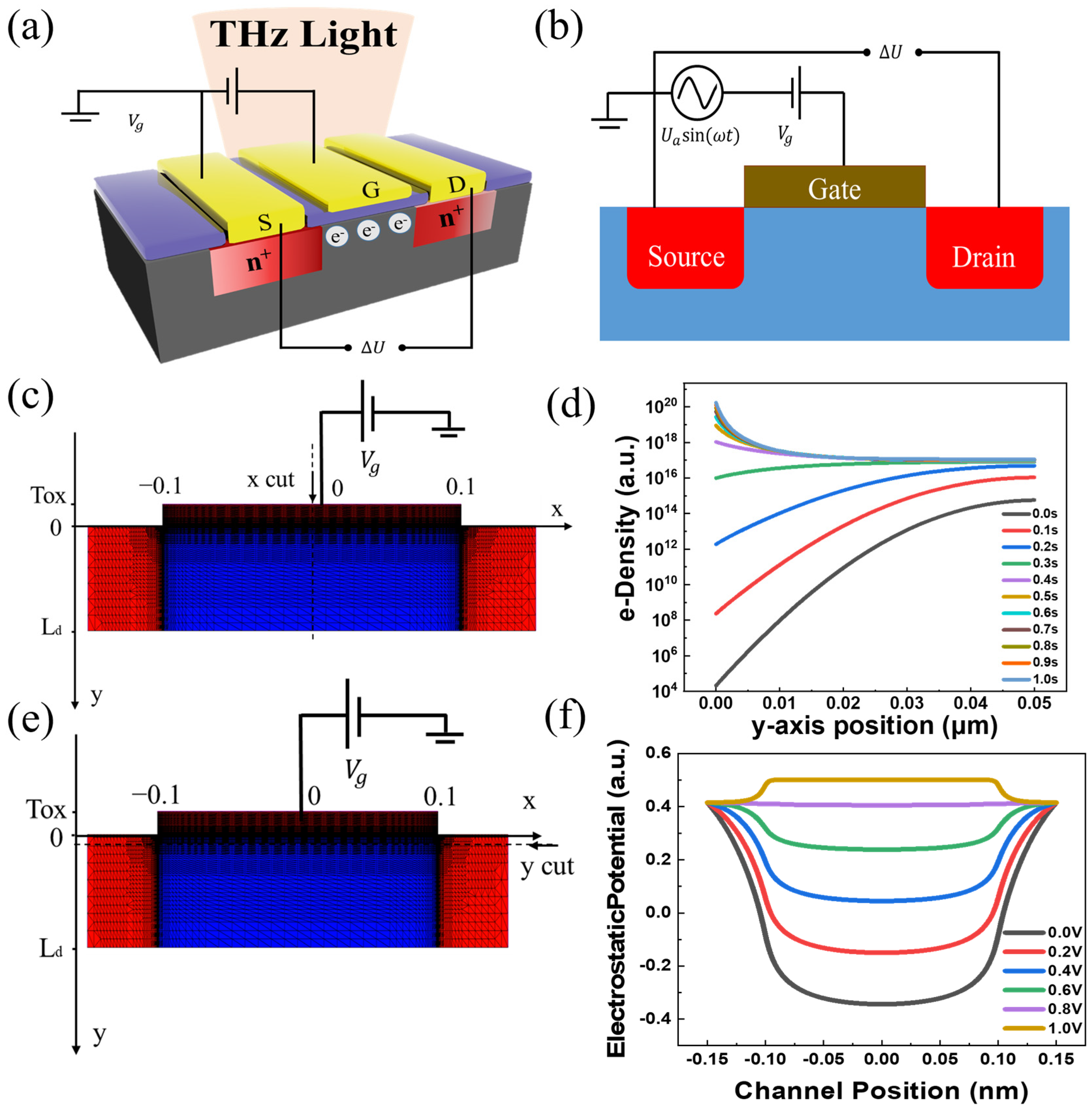
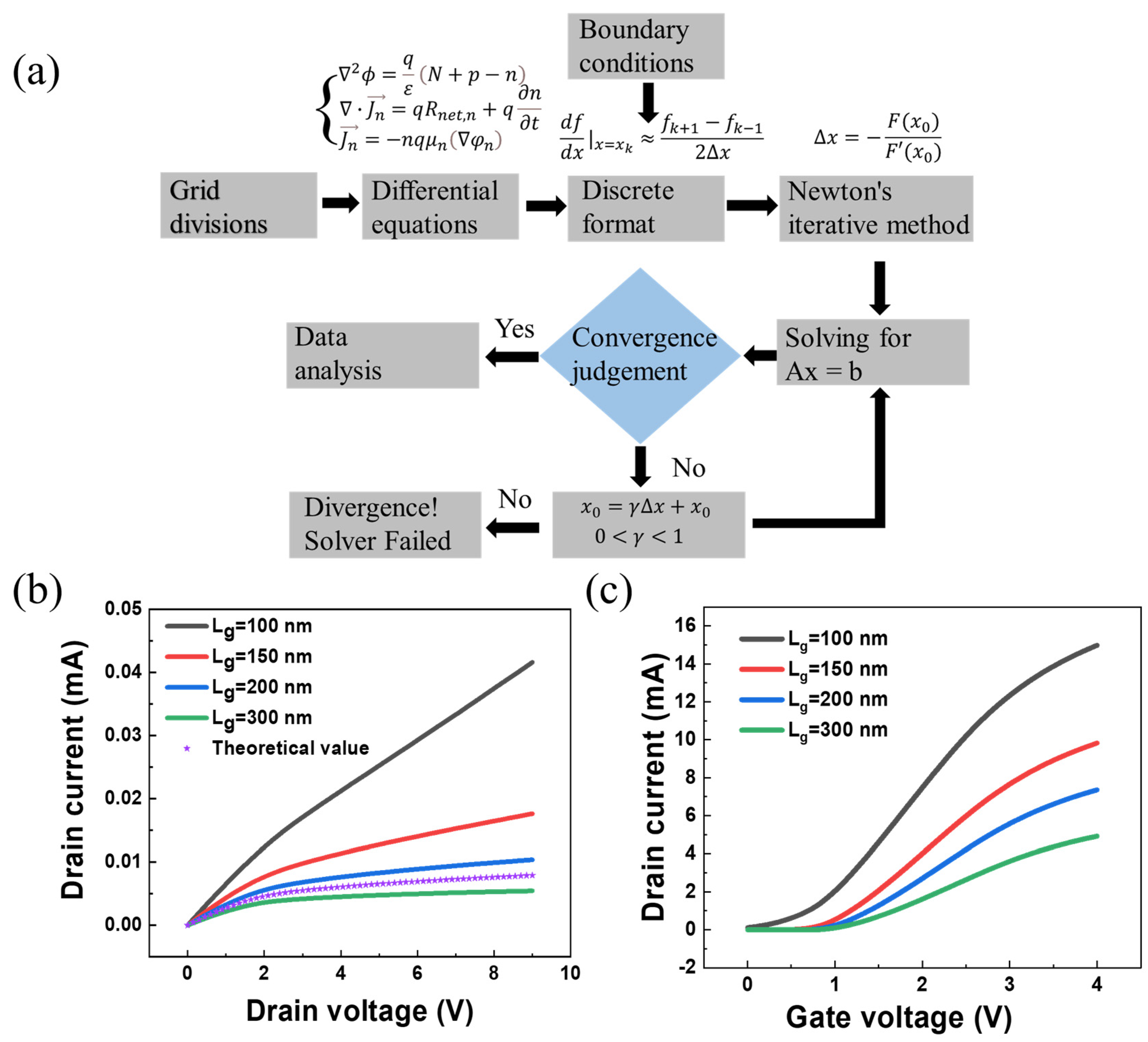
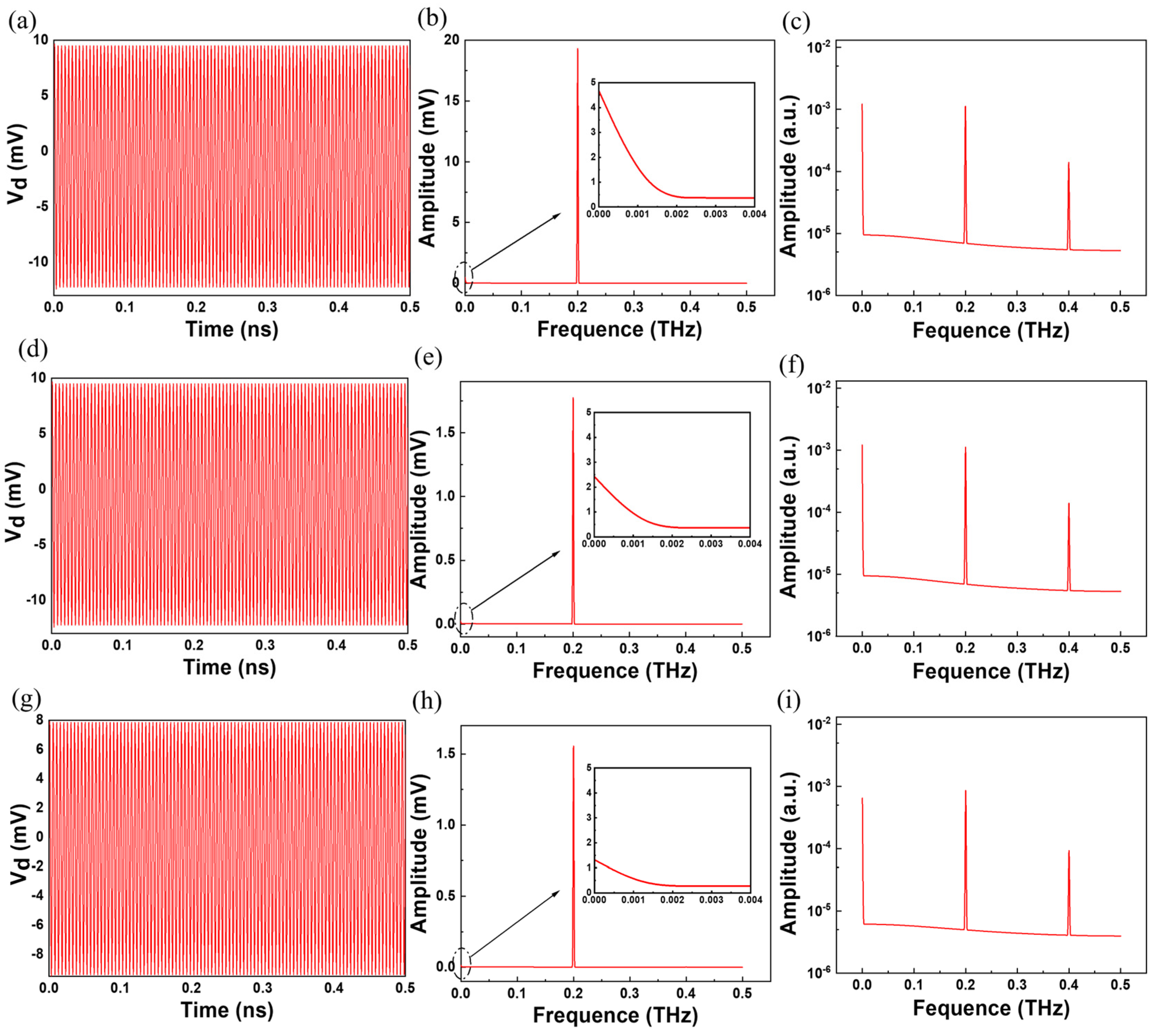
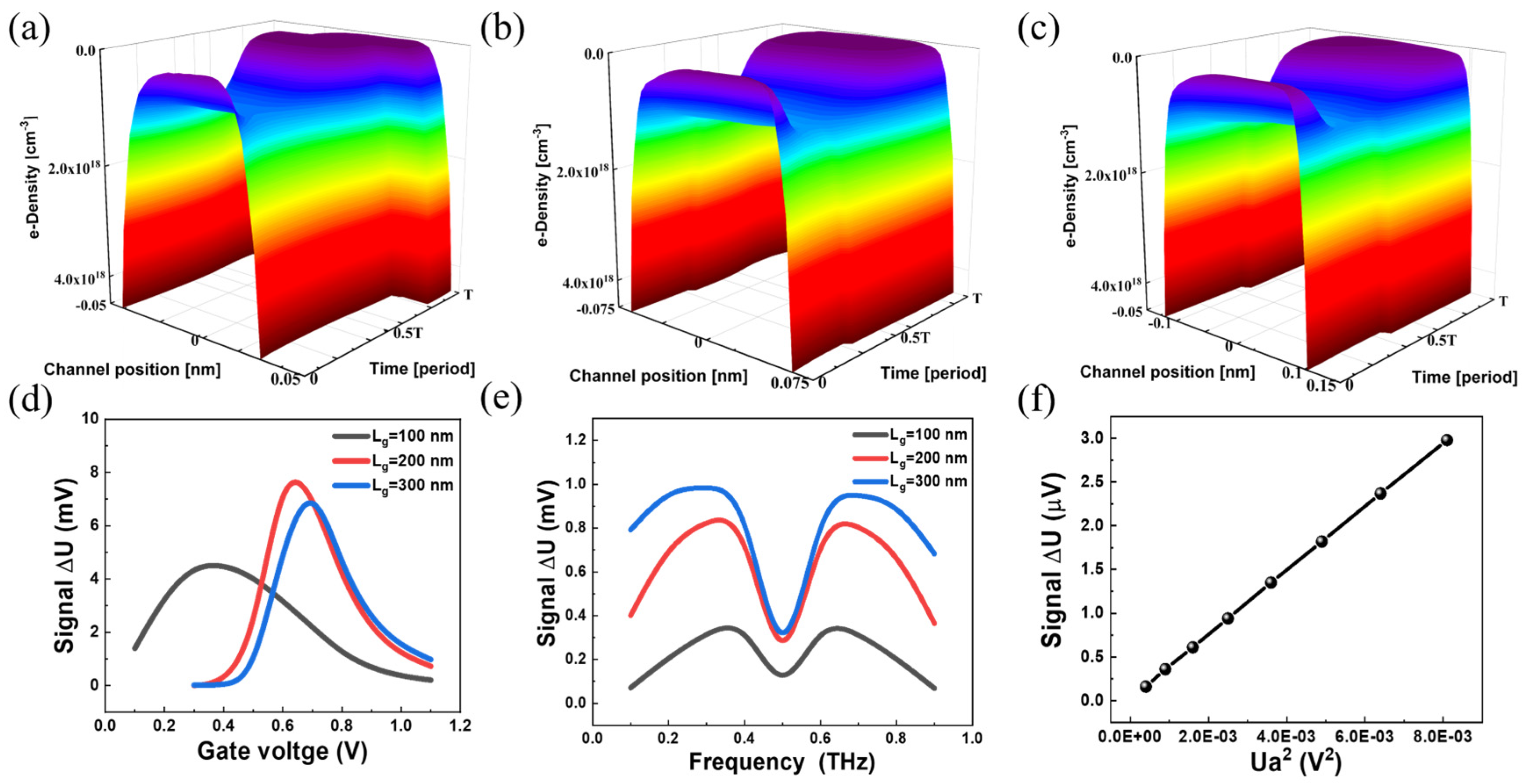
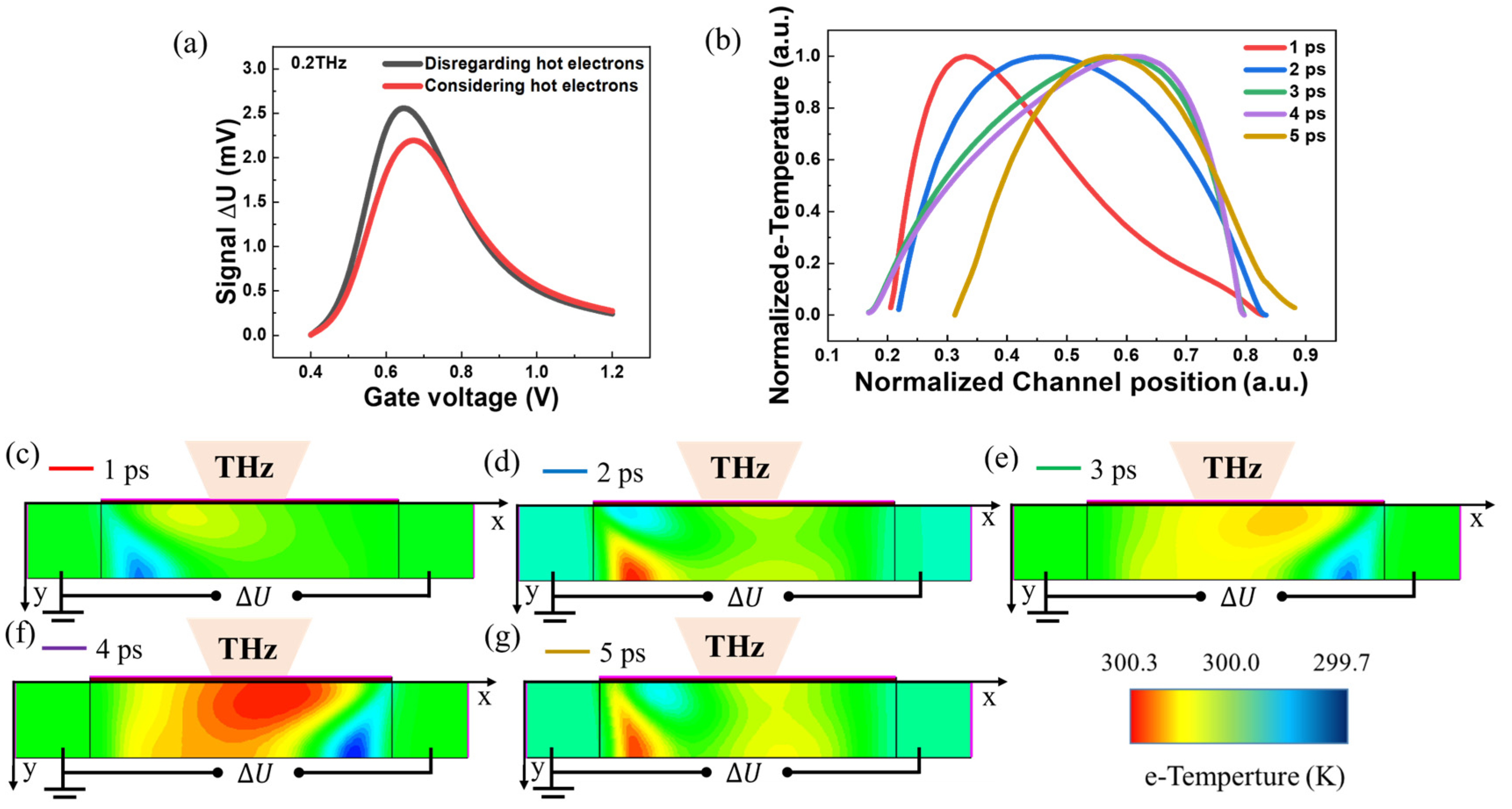
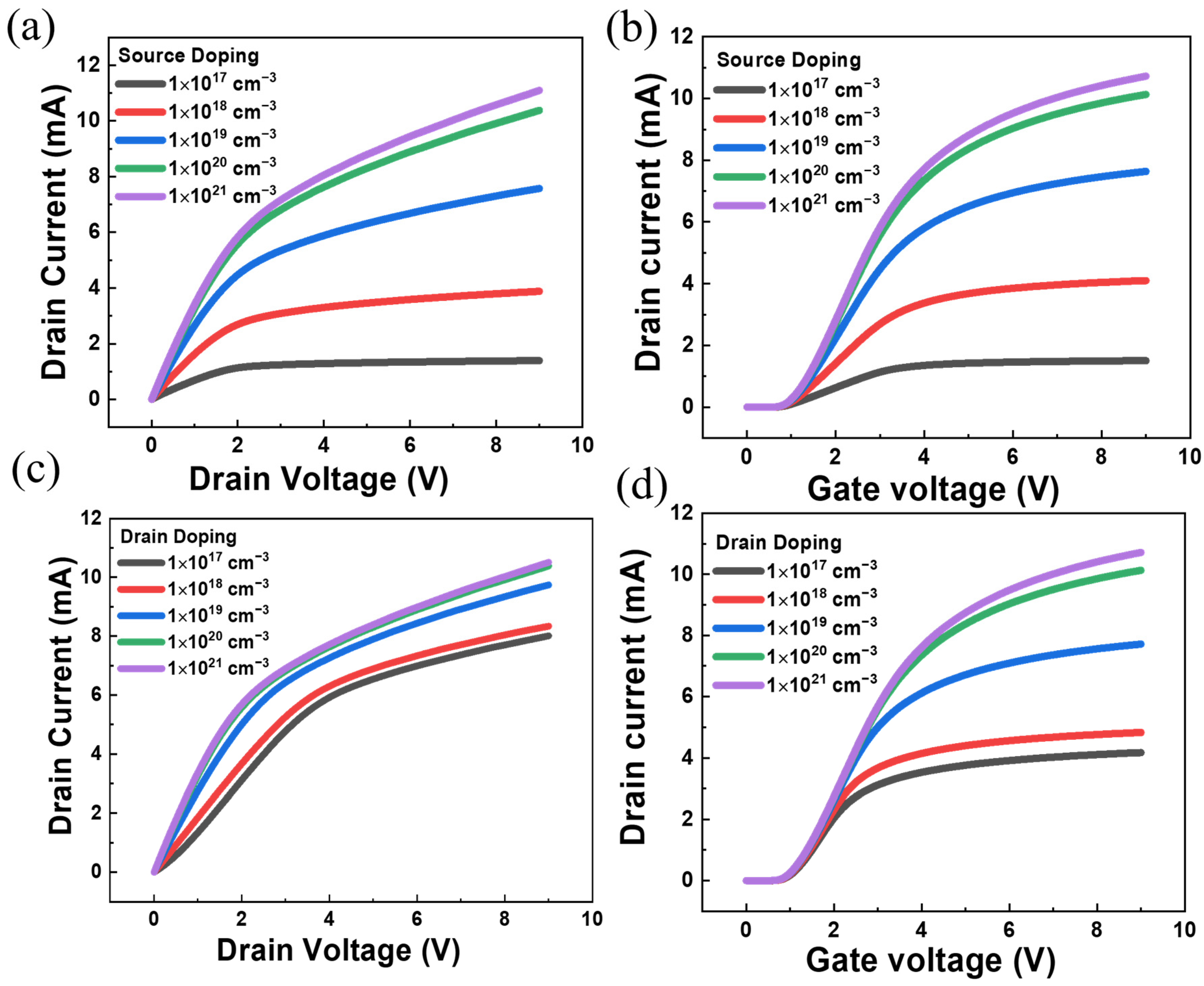
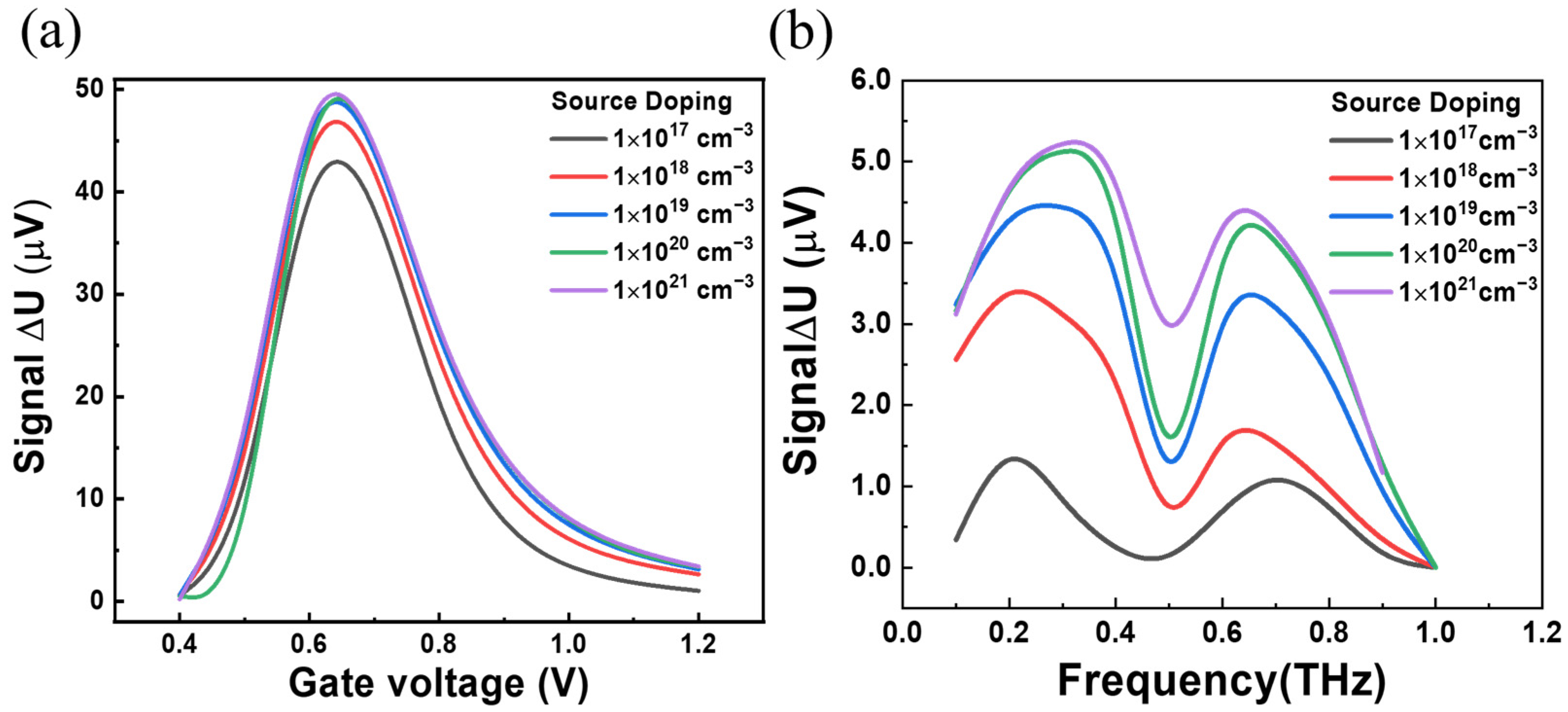
| Properties | Si |
|---|---|
| Effective density of states in the conduction band, Nc (cm−3) | |
| Effective density of states in the valence band, Nv (cm−3) | |
| Electron affinity (V) | 4.05 |
| Energy gap at 300 K (eV) | 1.12 |
| Minority carrier lifetime (s) | |
| Electron Mobility (drift) (cm2/V s) | 1500 |
| Hole Mobility (drift) (cm2/V s) | 450 |
Disclaimer/Publisher’s Note: The statements, opinions and data contained in all publications are solely those of the individual author(s) and contributor(s) and not of MDPI and/or the editor(s). MDPI and/or the editor(s) disclaim responsibility for any injury to people or property resulting from any ideas, methods, instructions or products referred to in the content. |
© 2023 by the authors. Licensee MDPI, Basel, Switzerland. This article is an open access article distributed under the terms and conditions of the Creative Commons Attribution (CC BY) license (https://creativecommons.org/licenses/by/4.0/).
Share and Cite
Wei, Y.; Yao, C.; Han, L.; Zhang, L.; Chen, Z.; Wang, L.; Lu, W.; Chen, X. The Microscopic Mechanisms of Nonlinear Rectification on Si-MOSFETs Terahertz Detector. Sensors 2023, 23, 5367. https://doi.org/10.3390/s23125367
Wei Y, Yao C, Han L, Zhang L, Chen Z, Wang L, Lu W, Chen X. The Microscopic Mechanisms of Nonlinear Rectification on Si-MOSFETs Terahertz Detector. Sensors. 2023; 23(12):5367. https://doi.org/10.3390/s23125367
Chicago/Turabian StyleWei, Yingdong, Chenyu Yao, Li Han, Libo Zhang, Zhiqingzi Chen, Lin Wang, Wei Lu, and Xiaoshuang Chen. 2023. "The Microscopic Mechanisms of Nonlinear Rectification on Si-MOSFETs Terahertz Detector" Sensors 23, no. 12: 5367. https://doi.org/10.3390/s23125367
APA StyleWei, Y., Yao, C., Han, L., Zhang, L., Chen, Z., Wang, L., Lu, W., & Chen, X. (2023). The Microscopic Mechanisms of Nonlinear Rectification on Si-MOSFETs Terahertz Detector. Sensors, 23(12), 5367. https://doi.org/10.3390/s23125367










